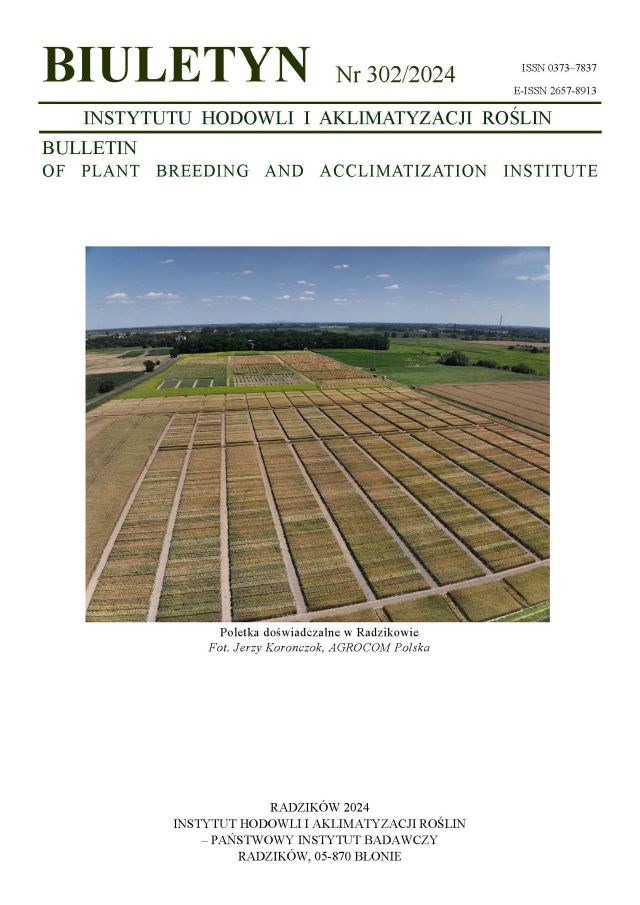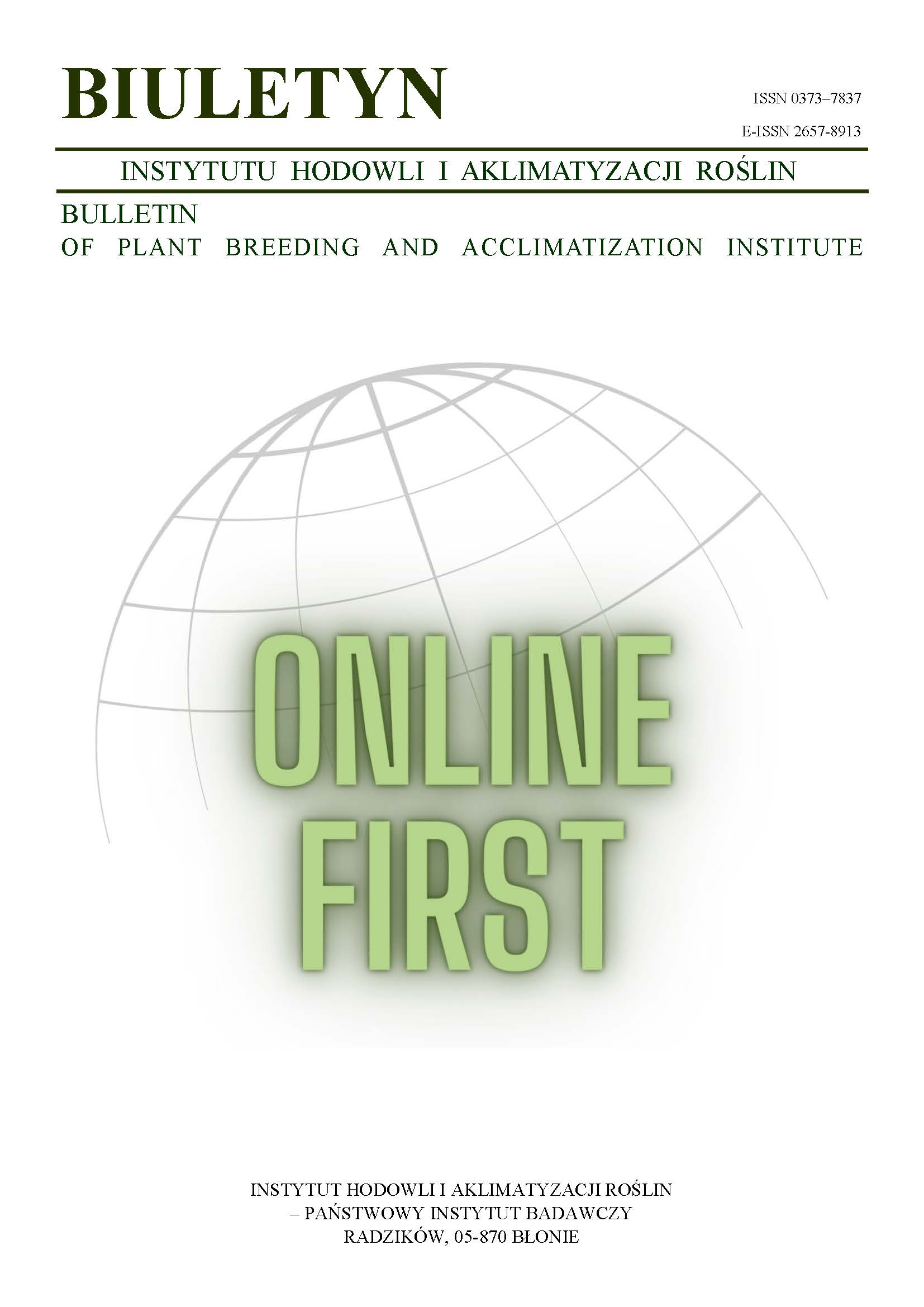Bacterial diseases of potato (Solanum tuberosum L.) — control strategies
Renata Lebecka
r.lebecka@ihar.edu.plZakład Genetyki i Materiałów Wyjściowych Ziemniaka, Instytut Hodowli i Aklimatyzacji Roślin, Oddział Młochów (Poland)
Ewa Zimnoch-Guzowska
Zakład Genetyki i Materiałów Wyjściowych Ziemniaka, Instytut Hodowli i Aklimatyzacji Roślin, Oddział Młochów (Poland)
Abstract
The paper describes the incidence and importance of main bacterial diseases of potato. The reaction of potato to infection with bacteria causing blackleg, soft rot, ring rot and brown rot is compared. Moreover control strategies against these bacterial diseases of potato are discussed.
Keywords:
blackleg, soft rot, ring rot, brown rot, resistanceReferences
Bain R. A., Pérombelon M. C. M., Tsror L., Nachmias A. 1990. Blackleg development and tuber yield in reaction to numbers of Erwinia carotovora subsp. atroseptica on seed tubers. Plant Pathol. 39: 125 — 133.
DOI: https://doi.org/10.1111/j.1365-3059.1990.tb02483.x
Google Scholar
Bergey D. H., Harrison F. C., Breed R. S., Hammer B. W., Huntoon F. M. 1923. In: Bergey's Manual of Determinative Bacteriology, 1st ed., The Williams & Wilkins Co, Baltimore: 1 — 442.
Google Scholar
Bugbee W. M., Gudmestad N. C. 1988. The recovery of Corynebacterium sepedonicum from sugarbeet seed. Phytopathology 78: 205 — 208.
DOI: https://doi.org/10.1094/Phyto-78-205
Google Scholar
Burkholder W. H., McFadden L. A., Dimock A. V. 1953. A bacterial blight of chrysanthemums. Phytopathology 43: 522 — 526.
Google Scholar
Carputo D., Cardi T., Speggiorin M., Zoina A., Frusciante L. 1997. Resistance to blackleg and tuber soft rot in sexual and somatic interspecific hybrids with different background. Am. Potato J. 74: 161 — 172.
DOI: https://doi.org/10.1007/BF02851595
Google Scholar
Chakrabarti S. K., Gadewar A. V., Gopal J., Shekhawat G. S. 1994. Performance of tetraploid × diploid (TD) crosses of potato for bacterial wilt resistance in India. ACIAR Bacterial Wilt Newsl. 10: 7.
Google Scholar
Davis M. J., Gillaspie A. G., Vidaver A. K., Harris R. W. 1984. Clavibacter: a new genus containing some phytopathogenic coryneform bacteria, including Clavibacter xyli subsp. xyli sp. nov., subsp. nov, and Clavibacter xyli subsp. cynodontis, subsp. nov., pathogens that cause ratoon stunting disease of sugarcane and bermudagrass stunting disease. Int. J. Syst. Bacteriol. 34: 107 — 117
DOI: https://doi.org/10.1099/00207713-34-2-107
Google Scholar
De Maine M. J., Lees A. K., Muir D. D., Bradshaw J. E., Mackay G. R. 2000. Long-day-adapted Phureja as a resource for potato breeding and genetic research. Potato Global Research and Development. Proceedings of the Global Conference on Potato, S. M. P. Khurana, G. S. Shekhawat, B. P. Sing, S.K. Pandey (eds.). New Delhi, India, 6–11.12.1999: 134 — 137.
Google Scholar
Dye D. W. 1969. A taxonomic study of the genus Erwinia. II. The "carotovora" group. New Zealand J. Sci. 12: 81 — 97.
Google Scholar
Easton G. D. 1979. The biology and epidemiology of potato ring rot. Am. Potato J. 56: 459 — 460.
Google Scholar
Elsas van J. D., van Overbeek L. S., Smalla K., Bailey M. J., Trigalet A., Marco Y., Lopes M. M. 2002. The fate, activity and spread of R. solanacearum biovar 2 in European habitats. Book of Abstracts of 3rd International Bacterial Wilt Symposium, 4–8.02.2002, South Africa: 5 p.
Google Scholar
Elsas van J. D., Kastelein P., van Bekkum P., van der Wolf J. M., de Vries P. M., van Overbeek L. S. 2000. Survival of Ralstonia solanacearum biovar 2, the causative agent of potato brown rot, in field and microcosm soils in temperate climates. Phytopathol. 90: 1358 — 1366.
DOI: https://doi.org/10.1094/PHYTO.2000.90.12.1358
Google Scholar
Fock I., , Luisetti J., Collonier C., Vedel F., Ducreux G., Kodja H., Sihachakr D. 2002. Solanum phureja and S. stenotomum as sources of resistance to Ralstonia solanacearum in somatic hybrids of potato. Book of Abstracts of 3rd International Bacterial Wilt Symposium 4–8.02.2002, South Africa: 47 pp.
Google Scholar
French E. R., Anguiz R., Aley P. 1997. The usefulness of potato resistance to Ralstonia (Pseudomonas) solanacearum for the integrated control of bacterial wilt. II conference IBWS: Disease Management, 22–27 June 1997, Guadelupe.
DOI: https://doi.org/10.1007/978-3-662-03592-4_58
Google Scholar
Gamard P., de Boer S. H. 1995. Evaluation of antagonistic bacteria for suppression of bacterial ring rot. Europ. J. Plant Pathol. 101: 519 — 525.
DOI: https://doi.org/10.1007/BF01874476
Google Scholar
Hartman G. L., Elphinstone J. G. 1994. Advances in the control of Pseudomonas solanacearum race 1 in major food crops. Bacterial wilt. The disease and its causative agent, Pseudomonas solanacearum. A. C. Hayward and G. L. Hartman (eds.). CAB International, Wallingford, U.K.: 157 — 177.
Google Scholar
Hauben L., Moore E. R. B., Vauterin L., Steenackers M., Verdonck L., Swings J. 1998. Phylogenetic position of phytopathogens within the Enterobacteriacae. Syst. Appl. Microbiol. 21:384 — 397.
DOI: https://doi.org/10.1016/S0723-2020(98)80048-9
Google Scholar
Hayward A. C. 1991. Biology and epidemiology of bacterial wild caused by Pseudomonas solanacearum. Annu. Rev. Phytopathol. 29: 65 — 87.
DOI: https://doi.org/10.1146/annurev.py.29.090191.000433
Google Scholar
Helgeson J. P., Haberlach G. T., Ehlenfeldt M. K., Hunt G., Pohlman J. D. , Austin S. 1993. Sexual progeny of somatic hybrids between potato and Solanum brevidens: potential for use in breeding programs. Am. Potato J. 70: 437 — 452.
DOI: https://doi.org/10.1007/BF02849063
Google Scholar
Hide G. A., Welham S. J., Read P. J., Ainsley A. E. 1996. The yield of potato plants as affected by stem cancer (Rhizoctonia solani), blackleg (Erwinia carotovora subsp. atroseptica) and by neighboring plants. J. Agr. Sci. 126: 429 — 440.
DOI: https://doi.org/10.1017/S0021859600075511
Google Scholar
Huaman Z., de Lindo L., Elphinstone J. G. 1988. Resistance to blackleg and soft rot and its potential use in breeding. Report of the Planning Conference on bacterial Diseases of the Potato 1987, E. R. French (ed.). International Potato Center, Lima, Peru: 215 — 228.
Google Scholar
Ishimaru C. A., Lapitan N. L., VanBuren A., Fenwick A., Pedas K. 1994. Identification of parents suitable for molecular mapping of immunity and resistance genes in Solanum species. Am. Potato J. 71: 517 — 533.
DOI: https://doi.org/10.1007/BF02851324
Google Scholar
Iwanaga M. 1985. Ploidy level manipulation approach development of diploid populations with specific resistance and FDR 2n pollen production. Report of the 26th Planning Conference: Present and future strategies for potato breeding and improvement. 12–14 December 1983. International Potato Center, Lima, Peru: 57 — 70.
Google Scholar
Janse J. D. 1988. A detection method for Pseudomonas solanacearum in symptom less potato tubers and some data on its sensitivity and specificity. EPPO/OEPP Bulletin 18: 343 — 351.
DOI: https://doi.org/10.1111/j.1365-2338.1988.tb00385.x
Google Scholar
Kinyua Z. M., Smith J. J., Lung’aho C., Olanya M., Priou S. 2001. On-farm successes and challenges of producing bacterial wilt-free tubers in seed plots in Kenya. African Crop Sci. J. 9: 279 — 285.
DOI: https://doi.org/10.4314/acsj.v9i1.27649
Google Scholar
Kriel C. J., Jansky S.H., Gudmestad N. C., Ronis D. H. 1995. Immunity to Clavibacter michiganensis subsp. sepedonicus: screening of exotic Solanum species. Euphytica 82: 125 — 132.
DOI: https://doi.org/10.1007/BF00027058
Google Scholar
Laferriere L. T., Helgeson J. P., Allen C. 1999. Fertile Solanum tuberosum plus somatic hybrids as sources of resistance to bacterial wilt caused by Ralstonia solanacearum. Theor. Appl. Genet. 98: 1272 — 1278.
DOI: https://doi.org/10.1007/s001220051193
Google Scholar
Laurila J., Metzler M. C., Ashimaru C A., Rokka V. M. 2003. Infection of plant material derived from Solanum acaule with Clavibacter michiganensis subsp. sepedonicus: temperature as a determining factor in immunity of S. acaule to bacterial ring rot. Plant Pathol. 52: 496 — 504.
DOI: https://doi.org/10.1046/j.1365-3059.2003.00866.x
Google Scholar
Lebecka R., Zimnoch-Guzowska E., Kaczmarek Z. 2004. Resistance to soft rot (Erwinia carotovora subsp. atroseptica) in tetraploid potato families obtained from 4x-2x crosses. Am. J. Potato Res. 82: 107 — 114.
DOI: https://doi.org/10.1007/BF02853586
Google Scholar
McLaughlin R. J., Sequeira L. 1988. Evaluation of an avirulent strain of Pseudomonas solanacearum for biological control of bacterial wilt of potato. Am. Potato J. 65: 255 — 268.
DOI: https://doi.org/10.1007/BF02854051
Google Scholar
Mills D., Russell B. W., Hanus J. W. 1997. Specific detection of Clavibacter michiganensis subsp. sepedonicus by amplification of three unique DNA sequences isolated by subtraction hybridization. Phytopathology 87: 853 — 861.
DOI: https://doi.org/10.1094/PHYTO.1997.87.8.853
Google Scholar
Montanelli, C., Stefanini F. M, Chiari A., Chiari T., Nascari G. 1995. Variability in the response to Pseudomonas solanacearum of transgenic lines of potato carrying a cecropin gene analogue. Potato Res. 38: 371 — 378.
DOI: https://doi.org/10.1007/BF02357742
Google Scholar
Muller H. J., Ficke W. 1974. [Bacterial ring rot (Corynebacterium sepedonicum) a dangerous quarantine disease for potato cultivation]. Nachrichtenblatt für den Pflanzenschutz in der DDR 28: 159 — 160.
Google Scholar
Nelson G. A. 1985. Survival of Corynebacterium sepedonicum in potato stems and on surfaces held at freezing and above-freezing temperatures. Am. Potato J. 62: 23 — 28.
DOI: https://doi.org/10.1007/BF02871296
Google Scholar
Pastrik K. H., Maiss E. 2000. Detection of Ralstonia solanacearum in. potato tubersby polymerase chain reaction. J. Phytopathol. 148: 619 — 626.
DOI: https://doi.org/10.1046/j.1439-0434.2000.00567.x
Google Scholar
Pastrik K. H., Müller P., Kakau J., Abdel-Kader D., Seigner L. 2004. Examination of sugar beet as a host for Clavibacter michiganensis ssp. sepedonicus, the causal agent of ring rot of potato. Gesunde Pflanzen, Springer-Verlag Heidelberg, Vol. 56, 4–5: 122 — 128.
DOI: https://doi.org/10.1007/s10343-004-0041-z
Google Scholar
Pastuszewska T., Junosza-Kisielewska I. 2004. Reakcja wybranych odmian ziemniaka na inokulację bakteriami Clavibacter michiganensis subsp. sepedonicus. Post. Ochr. Roślin 44 (2): 1014 — 1016.
Google Scholar
Pérombelon M. C. M. 2000. Blackleg risk potential of seed potatoes determined by quantification of tuber contamination by the causal agent and Erwinia carotovora subsp. atroseptica: a critical review. EPPO/OEPP Bulletin 30: 413 — 420.
DOI: https://doi.org/10.1111/j.1365-2338.2000.tb00921.x
Google Scholar
Pérombelon M. C. M., Kelman A. 1980. Ecology of the soft rot erwinia’s. Annu. Rev. Phytopathol. 18: 361 — 387.
DOI: https://doi.org/10.1146/annurev.py.18.090180.002045
Google Scholar
Pérombelon M. C. M., Kelman A. 1987. Blackleg and other potato diseases caused by soft rot erwinia’s: proposal for revision of terminology. Plant Dis. 71: 283 — 285.
Google Scholar
Pietkiewicz J. B. 1980. Variation in the reaction of potato tubers to diseases. Potato Res. 23:473.
Google Scholar
Polski katalog odmian ziemniaka. 1999. IHAR, Bonin: 1 — 200.
Google Scholar
Rhodes D. J., Logan C. 1986. Effects of fluorescent pseudomonads on the potato blackleg syndrome. Ann. Appl. Biol. 108: 511 — 518.
DOI: https://doi.org/10.1111/j.1744-7348.1986.tb01989.x
Google Scholar
Robinson K., Foster G. 1987. Quantitative assessment of tuber contamination by pectolytic erwinia and its possible use in the prediction and control of blackleg. Potato Res. 30: 669 — 674.
DOI: https://doi.org/10.1007/BF02367646
Google Scholar
Rowe P. R., Sequeira L. 1970. Inheritance of resistance to Pseudomonas solanacearum in Solanum phureja. Phytopathol. 60: 1499 — 1501.
DOI: https://doi.org/10.1094/Phyto-60-1499
Google Scholar
Sangar R. B. S. 1993. Efficacy of agro-practices to control bacterial wilt of potatoes in central India. J. Indian Potato Assoc. 20 (2): 172 — 173.
Google Scholar
Schmiediche P. 1986. Breeding potatoes for resistance to bacterial wilt caused by Pseudomonas solanacearum. Proceedings of an international workshop held at PCARRD: Bacterial wilt disease in Asia and the South Pacific. G. J. Persley (ed.). Los Banos, Philippines, 8–10 October 1985: 105 — 111.
Google Scholar
Schmiediche P. 1988. Breeding for resistance to Pseudomonas solanacearum. Report of the planning conference: Bacterial disease of the potato. International Potato Center, Lima, Peru: 19 — 28.
Google Scholar
Smith I. M., McNamara D. G., Scott P. R., Holderness M. 1997. Ralstonia solanacearum. Quarantine Pest for Europe, 2nd ed. EPPO/CABI.
Google Scholar
Smith J. J., Offord L. C., Holderness M., Saddler G. S. 1995. Pulsed-field gel electrophoresis analysis of Pseudomonas solanacearum. EPPO/OEPP Bulletin 25: 163 — 167.
DOI: https://doi.org/10.1111/j.1365-2338.1995.tb01454.x
Google Scholar
Stevenson W. R., Loria R., Franc G. D., Weingartner D. P. 2001. Compendium of potato diseases, 2nd ed. American Phytopathological Society. St. Paul, M N, USA.
Google Scholar
Wegener C. D. 2002. Induction of defence responses against Erwinia soft rot by an endogenous pectate lyase in potatoes. Physiol. Mol. Plant Pathol. 60: 91 — 100.
DOI: https://doi.org/10.1006/pmpp.2002.0377
Google Scholar
Wolf van der J. M., Mansfeld-Giese K., Müller P., Karjalainen R., Stead D. 2002. Epidemiological studies for control of Clavibacter michiganensis ssp. sepedonicus, the causal agent of bacterial ring rot in potato. Abstracts of Papers and Posters, 15th Triennial Conference of the EAPR: Potatoes today and tomorrow, G. Wenzel i I. Wulfert (eds.). 14–19 July 2002, Hamburg, Germany: 142.
Google Scholar
Wolf van der J., Pérombelon M. C. M. 1997. Potato brown rot in temperate regions — a review. http://www.spud.co.uk/external/PROF/RESEARCH/scri/brownro3.htm.
Google Scholar
Yabuuchi E., Kosako Y., Yano I., Hotta H., Nishiuchi Y. 1995. Transfer of two Burkholderia and an Alcaligenes species to Ralstonia gen. nov.: proposal of Ralstonia pickettii (Ralston, Palleroni, Doudoroff 1973) comb. nov., Ralstonia solanacearum (Smith 1896) comb. nov. and Ralstonia eutropha (Davis 1969) comb. nov. Microbiol. Immunol. 39: 897 — 904.
DOI: https://doi.org/10.1111/j.1348-0421.1995.tb03275.x
Google Scholar
Zimnoch-Guzowska E., Łojkowska E. 1993. Resistance to Erwinia in diploid potatoes with high starch content. Potato Res. 36: 177 — 182.
DOI: https://doi.org/10.1007/BF02360525
Google Scholar
Zimnoch-Guzowska E., Marczewski W., Lebecka R., Flis B., Schafer-Pregl R., Salamini F., Gebhardt C. 2000. QTL analysis of new sources of resistance to Erwinia carotovora ssp. atroseptica in potato done by AFLP, RFLP and resistance-gene-like markers. Crop Sci. 40: 1156 — 1167.
DOI: https://doi.org/10.2135/cropsci2000.4041156x
Google Scholar
Authors
Renata Lebeckar.lebecka@ihar.edu.pl
Zakład Genetyki i Materiałów Wyjściowych Ziemniaka, Instytut Hodowli i Aklimatyzacji Roślin, Oddział Młochów Poland
Authors
Ewa Zimnoch-GuzowskaZakład Genetyki i Materiałów Wyjściowych Ziemniaka, Instytut Hodowli i Aklimatyzacji Roślin, Oddział Młochów Poland
Statistics
Abstract views: 23PDF downloads: 8
License
Copyright (c) 2005 Renata Lebecka, Ewa Zimnoch-Guzowska

This work is licensed under a Creative Commons Attribution-ShareAlike 4.0 International License.
Upon submitting the article, the Authors grant the Publisher a non-exclusive and free license to use the article for an indefinite period of time throughout the world in the following fields of use:
- Production and reproduction of copies of the article using a specific technique, including printing and digital technology.
- Placing on the market, lending or renting the original or copies of the article.
- Public performance, exhibition, display, reproduction, broadcasting and re-broadcasting, as well as making the article publicly available in such a way that everyone can access it at a place and time of their choice.
- Including the article in a collective work.
- Uploading an article in electronic form to electronic platforms or otherwise introducing an article in electronic form to the Internet or other network.
- Dissemination of the article in electronic form on the Internet or other network, in collective work as well as independently.
- Making the article available in an electronic version in such a way that everyone can access it at a place and time of their choice, in particular via the Internet.
Authors by sending a request for publication:
- They consent to the publication of the article in the journal,
- They agree to give the publication a DOI (Digital Object Identifier),
- They undertake to comply with the publishing house's code of ethics in accordance with the guidelines of the Committee on Publication Ethics (COPE), (http://ihar.edu.pl/biblioteka_i_wydawnictwa.php),
- They consent to the articles being made available in electronic form under the CC BY-SA 4.0 license, in open access,
- They agree to send article metadata to commercial and non-commercial journal indexing databases.
Most read articles by the same author(s)
- Leszek Domański, Krystyna Michalak, Ewa Zimnoch-Guzowska, Variation of blackspot susceptibility of the selected potato cultivars , Bulletin of Plant Breeding and Acclimatization Institute: No. 246 (2007): Regular issue
- Renata Lebecka , Zofia Murawska , Katarzyna Szajko , Janusz Dębski , Michał Kistowski , Waldemar Marczewski , Ewa Zimnoch-Guzowska , Research on the expression and genetic characterization of the resistance to bacteria Dickeya solani in selected for resistance diploid potato , Bulletin of Plant Breeding and Acclimatization Institute: No. 286 (2019): Special issue
- Sylwester Sobkowiak, Hanna Zarzycka, Renata Lebecka, Ewa Zimnoch-Guzowska, Reaction of potato standards to Phytophthora infestans in resistance tests , Bulletin of Plant Breeding and Acclimatization Institute: No. 251 (2009): Regular issue
- Leszek Domański, Bogdan Flis, Henryka Jakuczun, Ewa Zimnoch-Guzowska, Assessment of breeding progress in relation to the processing value of potato parental lines released in 1999–2007 , Bulletin of Plant Breeding and Acclimatization Institute: No. 252 (2009): Regular issue
- Beata Tatarowska, Bogdan Flis, Ewa Zimnoch-Guzowska, Stability of resistance reaction to Phytophthora infestans (Mont.) de Bary of potato cultivars in laboratory tests , Bulletin of Plant Breeding and Acclimatization Institute: No. 271 (2014): Regular issue
- Leszek Domański, Ewa Zimnoch-Guzowska, Half-sib progeny evaluation and variability of potato breeding lines in respect to the mass of sprouts developed during storage season , Bulletin of Plant Breeding and Acclimatization Institute: No. 249 (2008): Regular issue
- Ewa Zimnoch-Guzowska, Małgorzata Gołębiewska, Exploitation of biotechnology by Polish plant breeding , Bulletin of Plant Breeding and Acclimatization Institute: No. 259 (2011): Regular issue
- Leszek Domański, Bogdan Flis, Henryka Jakuczun, Ewa Zimnoch-Guzowska, Variation of processing quality and tuber morphology traits in potato progenies derived from interploid matings 4x-2x , Bulletin of Plant Breeding and Acclimatization Institute: No. 257/258 (2010): Regular issue
- Leszek Domański, Dariusz R. Mańkowski, Bogdan Flis, Henryka Jakuczun, Ewa Zimnoch-Guzowska, The structure of multivariable phenotypic variation in potato progenies derived from tetraploid × diploid crosses , Bulletin of Plant Breeding and Acclimatization Institute: No. 265 (2012): Regular issue
- Henryka Jakuczun, Jarosław Przetakiewicz, Iwona Wasilewicz-Flis, Agnieszka Hara-Skrzypiec, Paulina Smyda, Ewa Zimnoch-Guzowska, Diploid potato hybrids — a source of resistance to potato wart disease (Synchytrium endobioticum (Schilb.) Perc.) , Bulletin of Plant Breeding and Acclimatization Institute: No. 268 (2013): Regular issue














